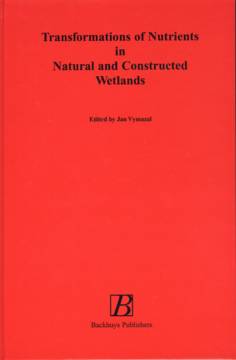

This volume resulted
from the workshop entitled "Nutrient Cycling and Retention in Natural and
Constructed Wetlands 111" which was held at Hotel Perslak near Treboit
in the Czech Republic on September 14-19, 1999. In order to avoid confusion
with the previous proceedings with the same title we decided to change the title
of the book to "Transformations of Nutrients in Natural and Constructed
Wetlands".
The workshop was attended by 35 participants from 13 countries from Europe,
Australia and North America. The theme of the workshop covered the following
topics: nutrient cycling in natural and constructed wetlands, carbon transformations
in wetlands, retention mechanisms and wetlands capacity, use of constructed
wetlands for various types of wastewater, retention nutrients by macrophytes,
physiological response of macrophytes to nutrient loads, water cycles, budgets
and evapotranspiration, wetland restoration or ecological functional assessment
of wetlands.
The workshop was planned, similar to two preceding workshops in 1995 and 1997,
to provide an opportunity for "applied" scientists working on functioning
constructed wetlands for wastewater treatment to meet scientists studying processes
occurring in natural wetland ecosystems. The idea of bringing both groups of
scientists together proved again to be very useful and we believe that both
groups benefited from the exchange of experience. The workshop was organized
by Jan Vymazal (Ecology and Use of Wetlands, Prague) and Jan Pokorny (Institute
of Botany, Czech Academy of Sciences, Trebon) and was partially supported by
grant GA CR 206/98/0727.
During the workshop 27 papers were presented orally and 3 poster papers were
displayed. This book contains 25 refereed contributions including all posters
(J. Pokorny, P. Pokorny and Piknova & Kvet). All oral presentations also
include discussion which was taped after the presentation and then "recovered"
by the editor. The discussion was left as it proceeded despite the fact that
some questions could be "answered" in the paper as a result of reviewers'
comments. The two papers by Dusek et al. were presented as one contribution
but the authors decided to split this paper and, therefore, the complete discussion
is included only after the paper by Dusek and Kvet.
The editor wants to thank all contributing authors for their effort and under-standing
with which they accepted editor's ideas, comments and requirements. The editor
also wants to thank the publisher, Mr. Wil R. Peters, for his excellent help
during the process of book edition and his support of this project.
Preface
Types of Constructed Wetlands for Wastewater Treatment: Their Potential for
Nutrient Removal
Jan Vymazal
Ecological Functional Assessment (EFA): A New Approach to Determining Wetland
Health
Curtis J Richardson and Kevin Nunnery
Functional and Structural Trajectory (FAST) Model to Predict Wetland Ecosystem
Development: A Case Study Using Constructed Salt Marshes Christopher B. Craft
Restoration of Spoil Heaps in Northwestern Bohemia Using Wetlands Emilie Pecharová,
Tomás Hezina, Jan Prochàzka, Ivo Priiryl and Jan Pokorny
Effect of Different Management Practices on Vegetation Development, Losses of
Soluble Matter and Solar Energy Dissipation in Three Small Sub-Mountain Catchments
Jan Prochàzka, Pavilna Hakrová, Jan Pokorny, Emilie Pecharova,
Tomás Hezina, Martin Sima and Libor Pechar
The Effect of Secondary Sewage Sludge on Retention of Nitrogen and Phosphorus
in Phragmites australis Growing in Constructed Wetlands
Teresa Ozimek, Hanna Obarska-Pempkowiak and Stanislaw Cytawa
Nitrogen and Phosphorus Removal in a Wetland Treating Sludge Dewatering Effluent
Karin Sundblad Tonderski and Anna Berggren
Wastewater Purification Efficiency in Experimental Treatment Wetlands in Estonia
Ülo Mander Valdo Kuusemets, Märt Öövel, Tõnu Mauring,
Raimo Ihme and Arnold Pieterse
Reed Dominated Intermittent Lake Cerknisko Jezero as a Sink for Nutrients
Alenka Gaberscik and Olga Urbanc-Bercic
Wastewater Treatment, With Emphasis On Nitrogen Removal, in a Constructed Wetland
Planted with Phragmites australis and Glyceria maxima
Lada Felberová, Ota Rauch and Jan Kvet
The Impact of Flow Pattern on Purification Efficiencies of Terrestrial Ecosystems
Planted with Ligneous Species in the MHEA® System
Marie Nemcova, Didier Cadelli and Michel Radoux
Nitrification and Denitrification in Hybrid Constructed Wetlands Systems
Paul Cooper
Constructed Wetlands for Wastewater Treatment in Portugal: a Global Overview
Verissimo N. Dias and Patricia M. Pacheco
Removal of Organics in Czech Constructed Wetlands with Horizontal Sub-Surface
Flow
Jan Vymazal
Dissipation of Solar Energy in Landscape Role of Vegetation, Impact of Drainage
on Local Climate, Policy Implication
Jan Pokorny
Experimental Approaches for Investigating Constructed Vertical Flow Wetland
Technology: From Bucket to Full-Scale
Neda Farahbakhshazad and Gregory M. Morrison
Phosphorus Dynamics in Event Driven Wetlands
Robert H. Kadlec
Growth Parameters of Common Reed (Phragmites australis (Cav.)Trin. Ex Steudel)
Planted in Constructed Wetlands
Jiri Dusek and Jan Kvet
Aboveground Growth Parameters of Phalaris arundinacea Planted in Constructed
Wetlands
Jiri Dusek, Jan Kvet and Zdenek Abrahám
Evapotranspiration of Small-Scale Constructed Wetlands Planted With Ligneous
Species
Andrea Kucerov', Jan Pokorny, Michel Radoux, Marie Nemcova, Didier Cadelli and
Jiri Dusek
Tertiary Wastewater Treatment and Biomass Production from the Point of View
of Heavy Metal Pollution
Zdenka Zakova
Is The Organic Load of Sediments the Cause of Nymphaeids Decline?
Pavla Piknova and Jan Kvet
Plant Growth and Nutrient Uptake in a Tropical Constructed Wetland
Tom O. Okurut
Nutrient Distribution Changes Within a Small Lake and its Catchment as Response
to Rapid Climatic Oscillations
Petr Pokorny
Removal of Stormwater-Associated Nutrients and Bacteria in Constructed Wetland
and Water Pollution Control Pond Systems
Cheryl M Davies, Karuppan Sakadevan and H. John Bavor
List of Participants
Subject index